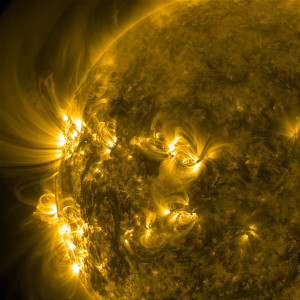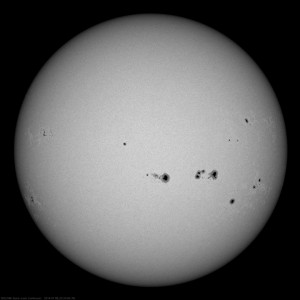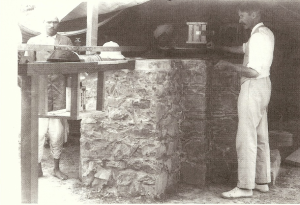I was never much of a binocular observer, even though I loved using binoculars in the daytime when I was a kid. I jumped from naked-eye observing straight to a 10-inch reflector as a teenager. Since starting at S&T, I’ve been “backtracking,” trying to view all those things people start with in binos. It gives me something to do when I have just a small patch of sky or time. I’m getting closer to knocking off the Astronomical League’s Bino Messier list, anyway.
Messier 34
16 11 2014Comments : Comments Off on Messier 34
Tags: M34
Categories : Binoculars, Observing
New England Fall Astronomy Festival
1 10 2014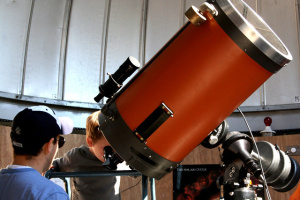
NH Observatory Manager Ian Cohen safely shows a young observer the Sun through the Observatory’s main telescope, a 14-inch reflector. Credit: Loni Anderson/NEFAF
Here’s hoping clear skies will come our way this month. First, there’s the total lunar eclipse to watch in the early a.m. hours of October 8 (evening hours of October 8 if you’re reading this from Australia). That’s super exciting, so it’s probably destined to coincide with cloudy weather.
But I’m also looking forward to the New England Fall Astronomy Festival later this month. Events will take place on the west end of the University of New Hampshire Campus (Durham) at the UNH Observatory. The weekend kicks off on Friday, October 17, with a 6 p.m. lecture by Carolyn Porco, Imaging Science Team Leader for the Cassini-Huygens Mission to Saturn. After the lecture and a Q&A session, clear skies will bring a chance to look through some great telescopes and listen to some star talks. The festival continues on Saturday (10 a.m. to midnight), with more observing sessions, activities for the kids (model rockets rumored!), talks, and clinics. I admit I’m pretty excited by the idea of a weather balloon launch.
Here’s a write up about a previous year’s NEFAF, in case you’re wondering what an “astronomy festival” looks like. Full disclosure: John Gianforte and I work together at S&T. Therefore, I know that it’s going to be a top-notch event.
Hope to see you there!
Comments : Comments Off on New England Fall Astronomy Festival
Categories : News, Observatories
Wallpaper Wednesday: SDO and Sunspots
16 07 2014Looking at some of the photos returned by NASA’s Solar Dynamics Observatory (SDO), you’d think contemporary solar observing had little in common with what was being done at Kodaikanal c. 1900-1910. But in addition to the dramatic images of solar loops like the one shown above, SDO also sends back sunspot records that closely resemble the photos and charts produced by C. Michie Smith, John Evershed, and company.
According to SDO/NASA:
“The Sun sported a whole slew of substantial sunspots over the past 11 days (July 1-10, 2014). This movie and still show the Sun in filtered white light speckled with more and larger sunspots than we have seen in quite some time. Sunspots are darker, cooler regions on the Sun created by intense magnetic fields poking through the surface. The Sun may have passed its peak level of activity, but it will still be producing many more sunspots and solar storms during the rest of this solar cycle. The still image was taken on July 8 at 22:24 UT.”
Looks familiar!
Visit the NASA/SDO gallery to see more images of solar activity. Like the two above images, most are stills excerpted from videos. Click through each image to reach the links to .mov and .mp4 files.
Comments : Comments Off on Wallpaper Wednesday: SDO and Sunspots
Categories : Instruments, Kodaikanal, NASA, Photography, Video
Sunspots, 1903
14 07 2014
Sunspot observation record, April 30-May 1, 1903. Image courtesy of Indian Institute of Astrophysics/JR
I was fortunate enough to spend some time studying the historic instruments and library collection at Kodaikanal Observatory in Tamil Nadu this past week. Run by the Indian Institute of Astrophysics, the observatory was founded in 1899 to facilitate solar observing. In 1907, John Evershed arrived on the scene to (quite famously) bring his “auto-collimating spectroheliograph” online. You can imagine my excitement when Mr. Selvendran, Senior In-Charge at KO, opened the door to the spectroheliograph room and slid open the shed roof to expose the instrument’s mirror. So cool.
But I’m getting ahead of myself. I spent my first day poking around KO’s fascinating library. Journals, books, catalogues, and ephemera stacked literally from floor to ceiling. So much stuff that I scarcely knew where to begin. But when I saw a stack of paper circles tucked into a corner shelf, I knew how I would spend the afternoon. I had only just read about these circles in one of C. Michie Smith’s (KO’s first director) annual reports.
Each of these 8-inch paper discs contains a record of 3-7 days of sunspot observations. Each spot was marked in pencil and assigned a letter (A, B, etc.). Every day, the observer recorded the new position and appearance of the lettered spots as they traversed the solar “surface”, i.e., the photosphere. For instance, in the following plates, sunspots A and B are shown moving from NNE to W between March 18 and 29, 1903.
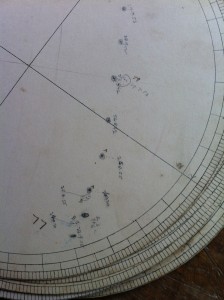
Sunspot Observations, March 18-29, 1903, detail. Image courtesy Indian Institute of Astrophysics/JR.
The next image shows that those same spots continued westward between March 30 and April 2, 1903, breaking up as they went. You can also see a second line of spots traveling roughly parallel to the solar equator. They started out as indistinct patches at the eastern edge of the disc on the March 27-28. The March 30-April 2 disc shows how long it took for them to move half way across the Sun.
According to C. Michie Smith, observers hand-recorded sunspots on 343 out of 365 days in 1904. What dedication, and this at a time when they didn’t really know what sunspots were. Observers just put in the hours and trusted that their efforts would one day lead to enlightenment.
Comments : Comments Off on Sunspots, 1903
Categories : Ephemera, Kodaikanal, Observatories
On Learning (and Un-Learning) the History of Astronomy
4 07 2014One of the challenges of working on the history of science is that I’m constantly having to forget things that I only just memorized or figured out. This need to learn/un-learn has been particularly acute since my arrival in Bangalore. I’ve been buried in the ephemera of the founding days of astrophysics—correspondence, observational data, eclipse photographs, equipment—and on Wednesday, I’ll be going up to Kodaikanal Observatory to study the historical instruments in situ. I’ve spent a lot of time puzzling through C. Michie Smith’s thoughts on the D line in the solar spectrum, and reading along as John Evershed’s thoughts on sunspots evolved over the course of a few decades.
It’s fascinating, watching a scientific argument grow, falter, and grow again.
The Indian Institute pf Astrophysics has a small collection of Evershed’s letters to and from William Huggins, F.R.S. Although friendly, the two men (and presumably Margaret Huggins and Mary Evershed, who remain in the background as “wives” even though they had a great deal to do with the science successes of both men) were quite cagey in their correspondence. They shared data and floated ideas without ever committing to a particular theory or revealing everything they knew. Reading the letters against their published papers shows that both astronomers left out more than than they included in their personal discussions; Evershed saw Huggins as a competitor as much as a mentor and friend.
Interesting stuff. But what I’ve really had to focus on this past couple of weeks, as I dig more deeply into the history of solar physics, is the art of comprehension without retention. That is, I need to understand Evershed’s early theories, but also need to forget about them as they were eventually proved incorrect. For example, yesterday I found myself drawing a line through my notes on Hervé Faye’s claim that the sunspots were caused by an upflow of material too hot to radiate properly, just to remind myself that later Evershed demonstrated that the upflow was cooler than the surrounding area. Sometimes I can see a problem with a theory based on my own knowledge; sometimes I have to wait until I’ve read three more Monthly Notices of the Royal Astronomical Society before I realize I need to forget a few more things.
The first article I picked up this morning started this cycle up again.
I’ve been looking at Norman Pogson’s original observation logs and comparing them with his published papers and catalogues. This morning, I found an interesting notice of his observations of Comet Biela in December 1872 (click on the image to download the entire notice):
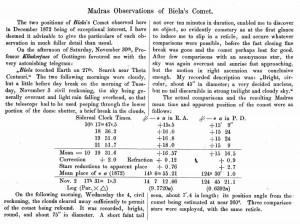
Norman R. Pogson, “Madras Observations of Biela’s Comet,” Astronomische Nachrichten, Vol. 84, (August 1874), pp. 183 – 186.
Kind of cool. But a quick Internet search tells me that Comet Biela was last sighted in 1852—fourteen years before Pogson’s viewing. I know Pogson was an under-appreciated astronomer, but is it possible we’ve completely forgotten about his observations?
As it turns out, Pogson’s claim that he had spotted Biela was challenged as early as January 1873. Pogson may have been misled in his identification by another astronomer, Klinkerfues, who told him to search for Biela near Theta Centauri. Or he may have been encouraged to identify the moving object as Biela since it was roughly coincident with what would later be identified as a Bielan meteor shower, created by the comet’s disintegration. However the confusion arose, by 1892, it was accepted fully that Pogson’s comet, now known as X 1872 X1, was not Biela at all, but some other object in motion. Pogson was able to record only two locations for his comet, so it is impossible to determine X 1872 X1’s orbit or period. Today, we may know X 1872 X1 by a second name, or Pogson may have made the comet’s only sighting before it broke up like Biela.

W. H. S. Monck, “Pogson’s Comet and the Bielan Meteors,” Publications of the Astronomical Society of the Pacific, Vol. 4, No. 21 (1892), p.19.
So, this morning, I learned that Norman Pogson observed Comet Biela from the Madras Observatory in December 1872. Approximately ten minutes later, I began the process of unlearning this bit of information and replacing it with conclusions drawn in the last two decades of the nineteenth century. After lunch, I may need to unlearn those bits as well and absorb instead analyses of X 1872 X made in the twentieth—or even better—twenty-first century.
Comments : Comments Off on On Learning (and Un-Learning) the History of Astronomy
Categories : Comets
India Calling
30 05 2014I took my first dose of live typhoid vaccine this morning, so I guess it’s official: I’m on my way back to India for the summer. One of the benefits of the ACLS NFF is the research budget—large enough to cover the cost of two conferences and a trip to India in the same academic year. So, in two weeks, I’ll be rolling into the library at the Indian Institute of Astrophysics in Bangalore to complete “step two” of a new research project. Last summer was “step one,” exploratory research in the Lick Observatory archives at UC-Santa Cruz. No idea what “step three” will look like!
This project is still in its infancy, but I’m looking at the ways in which “new astronomy” (i.e., spectroscopy) affected observatory design at the end of the nineteenth century. More specifically, I’m trying to track the intellectual shift of Indian astronomers away from the UK and toward the US in the era of solar astronomy. It seems that even though Kodaikanal Observatory was constructed in the (British) colonial era, the astronomers were working more closely with Mt Wilson and Lick Observatories than with their British counterparts. Maybe. Possibly. That’s the great thing about research questions: even if I come back with “wrong answer,” I’ll have learned something new.
Comments : Comments Off on India Calling
Categories : Kodaikanal
The Science of the Solar System
28 03 2014
Pluto System, Hubble Space Telescope. Image credit: NASA, ESA, H. Weaver (JPL/APL), A. Stern (SwRI), HST Pluto Companion Search Team
I’m the first to admit I don’t understand the MOOC (Massive Open Online Course) model of education. I can’t figure out how companies like Coursera make money by offering free courses and I can’t see how anyone thinks they MOOCs can replace a four-year university education. I’m an advocate of online education for some courses, in some forms, but not for an entire college education. But no one asked me, and as long as the instructor gets paid and the student gets some intellectual benefit, I have no complaints. I’ve taken one MOOC (on Thomas Jefferson, because hey, UVa), learned a lot, and found it a pretty good use of my spare time.
The preceding paragraph was just a warm-up for the real purpose of this post: to remind you that you’re running out of time to register for Mike Brown‘s free online course, The Science of the Solar System. Judging only from the intro video, it looks like it’s going to be a fun class. I saw Mike give a talk at NEAF last year and enjoyed it. His material was pitched at a good level, assuming his audience had enough knowledge to follow him, but was not made up of astrophysicists.
Plus, he was nice enough to autograph a copy of his book for my wife.
Also coming up is a MOOC on the technology of astronomy (AstroTech: The Science and Technology behind Discovery). I think I’ll be enrolled in this one. My research deals with Early Modern “astrotech” and it might be fun to look at a more contemporary perspective.
Comments : Comments Off on The Science of the Solar System
Categories : News
David Malin, The Invisible Universe
22 03 2014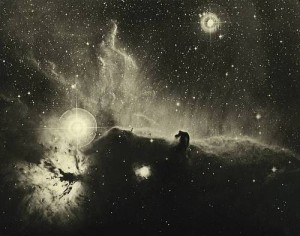
Dust and Gas Adrift in Orion (UKS 1). ©Anglo-Australian Observatory; ©Anglo-Australian Observatory/Royal Observatory, Edinburgh; ©Malin/IAC/RGO; ©Malin/Pasachoff/Caltech
The Invisible Universe, the lovely online exhibition of David Malin’s astrophotography at the Joseph Bellows Gallery, will be available for viewing for at least a couple more weeks. According to the gallery site, it will be viewable through April 2, 2014. This is one exhibition I wish I could view in person—there are few things more stunning than platinum-palladium prints, regardless of the subject.
David Malin was at the Anglo-Australian Observatory (now the Australian Astronomical Observatory, AAO) for twenty-six years as a photographic scientist-astronomer. If you are a fan of astrophotography, you have undoubtedly seen his most popular books, The Invisible Universe (1999) and Ancient Light (Phaidon, 2009).
The AAO owns the copyright for any of Malin’s images that required the use of the observatory’s instruments. David Malin Images manages the copyrights: follow this link for more information about photosales and reproduction rights.
Comments : Comments Off on David Malin, The Invisible Universe
Categories : Photography
Project Yosemite
3 03 2014I’ve mentioned Yosemite a few times over the past two years. I have family in California’s Central Valley, and when we visit, it sometimes seems as if the mountains are literally calling to me. Skywatching is amazing up there (if you can get past your fear of being eaten by a cougar) and there is no shortage of photographs and films to prove it. To wit: Project Yosemite recently released a second timelapse, ostensibly documenting a 200+ mile backpacking trip, but really giving us a good view of the park’s changing skies. Their first video, released in 2012, was stunningly beautiful. Yosemite HD II may be even better.
ETA: The air traffic over Yosemite never ceases to amaze me.
Comments : Comments Off on Project Yosemite
Categories : Video



